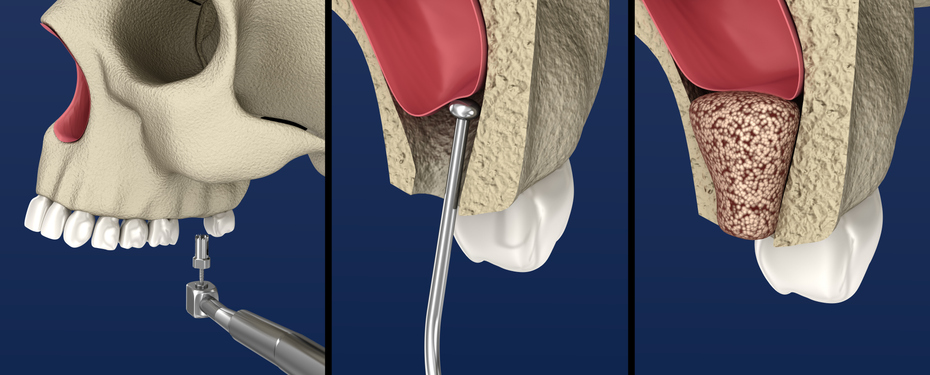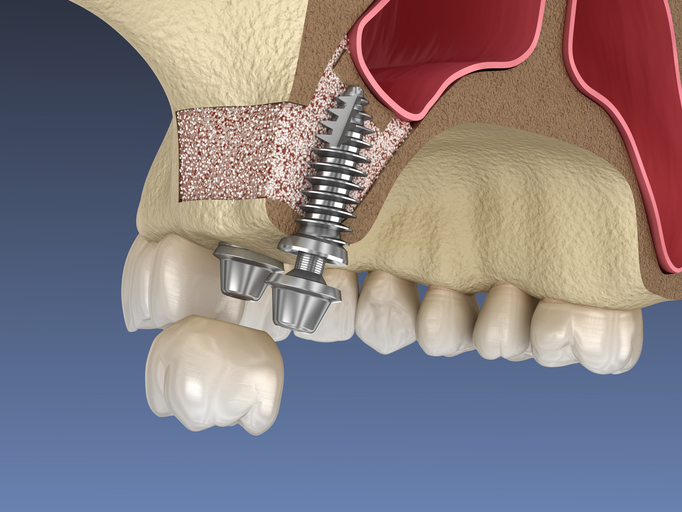If you’ve been told you need a sinus lift before getting dental implants, you might be feeling a little confused—or even a little nervous. What exactly is a sinus lift? Why do some people need one while others don’t? And what’s it like to go through the procedure?
Don’t worry, you’re not alone, and this post is here to clear up all the mystery. We’ll walk you through what a sinus lift is, why it matters for dental implants, what the process looks like, and how recovery works. By the end, you’ll know exactly what to expect and why it’s actually a smart move for long-term dental health.
What Is a Sinus Lift?
Let’s start with the basics. A sinus lift—also called a sinus augmentation—is a surgical procedure that adds bone to your upper jaw in the area near your molars and premolars. The goal? To make sure there’s enough bone to securely place dental implants.
Here’s the thing: your maxillary sinuses (those air-filled spaces above your upper teeth) sit right behind your cheeks and on top of your upper jawbone. Sometimes, the bone in that area isn’t thick enough or tall enough to hold an implant. That’s where a sinus lift for implants comes in.
In simple terms, the oral surgeon, Dr. David Scharf in Babylon, NY, “lifts” the sinus membrane upward and packs bone graft material into the space below it. This builds up the height of your bone so an implant can be safely placed later.


Why Would Someone Need a Sinus Lift?
Great question—and there are actually a few reasons why someone might not have enough bone in their upper jaw for dental implants:
1. Tooth Loss and Bone Resorption
If you lost your upper back teeth a while ago (especially molars), the jawbone in that area may have started to shrink. Bone resorption is a natural process after tooth loss—your body stops sending nutrients to the area because there’s no longer a tooth to support.
2. Natural Anatomy
Some people just naturally have large sinus cavities and less bone in the upper jaw. That combo makes it hard to securely anchor an implant without a little help.
3. Gum Disease or Infection
Periodontal disease can erode both gum tissue and bone. If you’ve had advanced gum issues in the past, your bone levels may be too low for implants on their own.
4. Previous Surgeries or Trauma
Injuries or surgical complications in the maxillary region can also lead to bone loss, making a sinus lift necessary for successful implant placement.
What Happens During a Sinus Lift Procedure?
If the idea of sinus surgery makes you squeamish, take a breath—it’s much more straightforward than it sounds. Sinus lifts are commonly performed by oral surgeons or periodontists like Dr. Scharf in Long Island, NY, and have a high success rate.
Here’s a general breakdown of what the procedure looks like:
Step 1: Consultation and Imaging
You’ll first meet with your dental specialist, who will take X-rays or an iCat scan (a 3D image of your jaw and sinuses). This shows how much bone is currently there and whether a sinus lift is needed.
Step 2: Surgery Day
You’ll be given local anesthesia, and in some cases, sedation. Your surgeon, Dr. Scharf, will make a small incision in the gum tissue where the implant will eventually go. Then, they create a window in the jawbone and gently push the sinus membrane upward to make space.
Step 3: Bone Grafting
Bone graft material (which might be from your body, a donor, or synthetic) is packed into the space created by lifting the sinus. This builds up the bone height in the area.
Step 4: Stitching and Healing
The gum is stitched up, and then you’ll go into healing mode. Over time, your body will integrate the bone graft and generate new, strong bone in that area.
What’s the Recovery Like After a Sinus Lift?
Good news—it’s typically not as bad as people imagine.
Most patients report mild to moderate discomfort, swelling, or a feeling of fullness in the cheek or sinus area. Pain is usually manageable with over-the-counter or prescribed medications, and many people are back to normal activities within a few days.
Here are a few common recovery tips:
- Don’t blow your nose (this can shift the graft)
- Avoid sneezing forcefully
- Sleep with your head elevated
- Stick to soft foods for the first few days
- Avoid smoking, as it interferes with healing
Dr. Scharf will likely give you antibiotics and a nasal spray to keep everything clear and infection-free.
How Long Does It Take to Heal?
This is the part that requires patience. After a sinus lift and bone graft, your jaw needs time to heal and grow new bone. It usually takes 4 to 9 months for the area to be ready for dental implants.
The healing time depends on:
- The amount of bone added
- Your body’s natural healing response
- Whether other procedures were done at the same time
In some cases, if enough bone is already present, the dental implant might be placed at the same time as the sinus lift. But often, they’re done in two separate stages.
Are Sinus Lifts Safe?
Yes, sinus lifts are generally very safe and routine when performed by a qualified oral surgeon or periodontist. Dr. Scharf is a periodontist in Babylon on Long Island, NY, with extensive training to perform complicated oral surgeries.
Of course, like any surgical procedure, there are risks. These can include:
- Sinus membrane perforation (usually repaired during the procedure)
- Infection
- Bleeding
- Graft rejection (rare)
- Chronic sinus issues (uncommon)
Your specialist will go over these in detail and explain how they minimize risk at every step.
What Kind of Bone Is Used in a Sinus Lift?
Another great question—there are several options:
- Autogenous bone (from your own body—often the hip or chin)
- Allograft (from a human donor, processed and safe)
- Xenograft (from an animal, usually bovine/cow)
- Synthetic materials
Each type has pros and cons in terms of integration time, availability, and cost. Dr. Scharf will choose the best one for your specific situation.
Cost of a Sinus Lift
Prices vary based on location, complexity, and the type of bone graft used, but generally, you can expect a sinus lift procedure to cost between $1,500 and $5,000 per side in New York.
This is separate from the cost of dental implants, which usually ranges from $3,000 to $6,000 per implant in New York.
While this might seem like a big investment, remember that a properly done implant sinus lift helps create the foundation for a successful, long-lasting implant. You’re building a solid base—literally and figuratively.
Can Everyone Get a Sinus Lift?
Not necessarily. You may not be a candidate if you:
- Have uncontrolled sinus infections
- Have certain systemic health conditions (like poorly controlled diabetes)
- Smoke heavily and aren’t willing to quit
- Have bone disorders or are undergoing cancer treatments
Dr. Scharf will carefully assess your overall health and imaging results to make sure a sinus lift is the right path for you.
Is a Sinus Lift Worth It?
Absolutely—if it’s what’s standing between you and a healthy, functional smile with dental implants.
A sinus lift for dental implants might sound like a big deal, but it’s a routine and highly successful procedure that’s opened the door to implant treatment for thousands of people who otherwise wouldn’t be candidates.
Yes, it adds time and cost to your treatment plan. But think about it this way: Would you rather cut corners and risk implant failure? Or would you rather invest in a rock-solid foundation that’ll last for decades?
With the right planning, skilled care, and a little patience during healing, a sinus lift can give you the best possible shot at a stable, confident, natural-looking smile.
Quick FAQ Recap
About 4 to 9 months for full healing before implants are placed.
Most patients report mild to moderate discomfort, not severe pain.
Sometimes, but usually only if there’s already enough bone present.
Yes, especially when done by an experienced oral surgeon or periodontist like Dr. Scharf.
Want more info about dental implants and sinus lifts/bone grafting? Reach out to Dr. David R. Scharf in Long Island, NY—he’ll guide you step-by-step. You don’t have to figure it all out alone.

